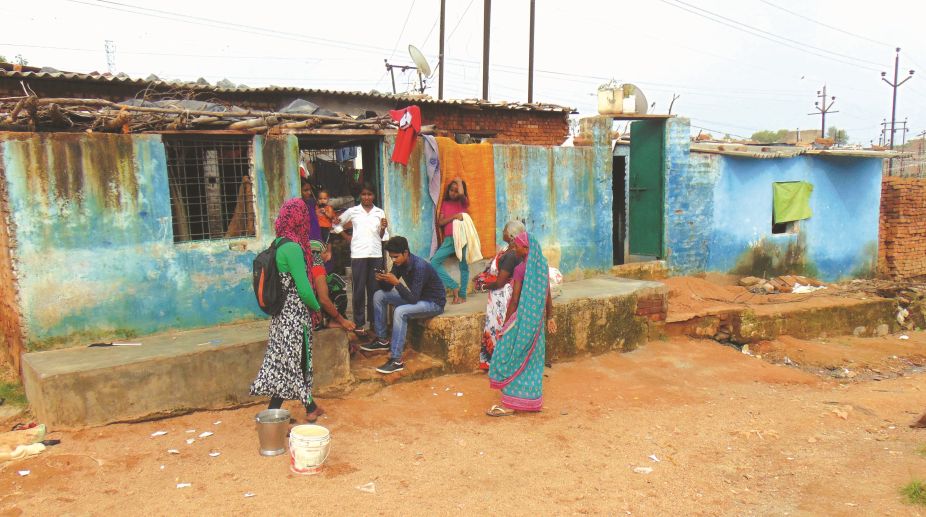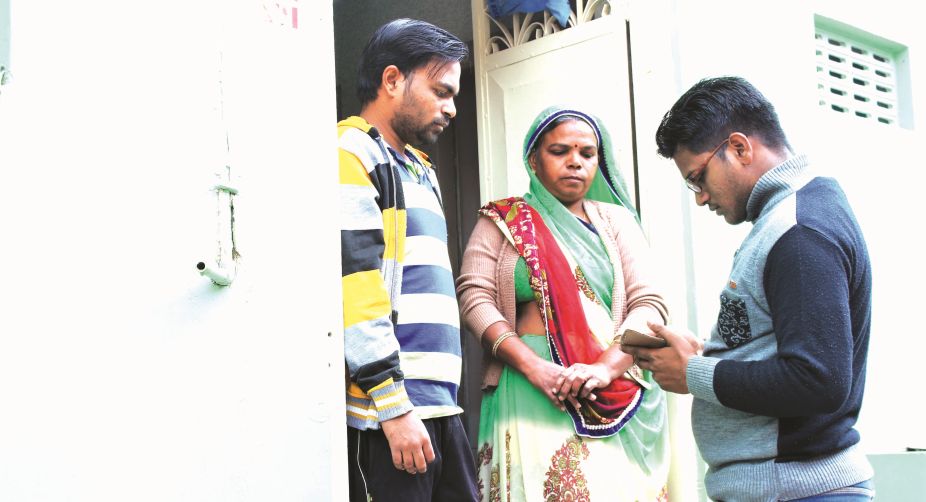Ruchi Gujjar, Indian actress, wears PM Modi necklace at Cannes 2025
Ruchi said, “PM Modi has transformed how the world sees India. This necklace is my way of carrying that pride on an international stage."

Jhansi Survey by SIC member-Hasari,ward no,02.
The year was 2014 when the newly-appointed Prime Minister Narendra Modi strongly advocated in his maiden Independence Day speech for building a toilet in every household in the country. Of course, his speech from the ramparts of Red Fort drew praise from every quarter of society as he mentioned how lack of toilet led to many problems, including sexual violence.
Soon after, building of toilets began very rapidly. As the deadline ends this October, everybody has one question in mind: How much progress has the campaign made so far? The answer is remarkable, if data is to be believed.
Advertisement
More than six crore toilets have been built under this Swachh Bharat Abhiyan ~ a tremendous achievement for this government. However, little did they know that this movement against open defecation will bring forth many other sanitation issues affecting the society.
Advertisement

Be it sewerage system, drainage system, manual scavenging or cleanliness, all these issues are plaguing the Indian society for a long time. This scenario is true not only of rural or Tier-3 or Tier-2 cities but metropolitan cities as well.
All thanks to this movement, which unearthed how our cities or rural areas have been facing sanitation problem for a long time. This is what Society for Participatory Research in Asia (PRIA), a global centre for participatory research based in New Delhi says in their research done in two cities ~ Ajmer and Jhansi ~ on sanitation situations.
The survey covered 6,582 households in all the 60 wards in Jhansi and 6,220 households in all the 60 wards in Ajmer. And their findings are, to put it mildly, disgraceful.
Unfortunately, open defecation remains a problem in these two cities, with 13 per cent of the slum households in Ajmer, and eight per cent of the slum households in Jhansi still practising open defecation.
Not only this, 48 per cent of the septic tanks in colonies and 64 per cent of the septic tanks in slums have never been cleaned in Ajmer. A similar situation is prevalent in Jhansi.
Apart from the open defecation issue, the study also gave insight into other sanitation problems, including solid waste management, toilet facilities, water outlets and drainage, water supply and bathing facilities in both cities.
This is the story of just two cities; imagine what would be the condition in rest of the country? Keeping all these things in mind the only conclusion that emerges is, if the government really wants a “Clean India”, they will have to focus on overall sanitation development, not just raising toilet structures.
Inside the cities
Ajmer city is part of Rajasthan and is famous for housing Ajmer Sharif Dargah, a shrine of the Muslim Sufi saint Garib Nawaz. Jhansi is in Uttar Pardesh and is part of the Bundelkhand region.
The survey was done for six months in 2017 and its purpose was to assess the ground realities of the Swachh Bharat Mission ~ Urban (SBM-U) for both cities. It covered 6,582 households in Jhansi and 6,220 households in Ajmer.
In Jhansi, 83 per cent of the households were taken from colonies while the remaining 17 per cent were from slums. In Ajmer, 79 per cent of the households were from colonies and 21 per cent from slums.

The survey reads that in Ajmer, 91 per cent of the colony households and Jhansi’s 89 per cent of colony households have individual household latrines.
However, when it comes to slums, both cities lag, with 80-81 per cent households having latrines. It means, around 20 per cent households still defecates in the open.
The study also pointed out that most of these houses rely on septic tanks. But what is the of concern here is that 48 per cent of the septic tanks in colonies and 64 per cent of the septic tanks in slums have never been cleaned in Ajmer.
The same scenario is seen in Jhansi, where 86 per cent of septic tanks in both colonies and slums have never been cleaned. But what is shocking is that around 54 per cent of all households in both cities informed that their septic tanks were cleaned with manual methods. This is the condition of two cities, which were chosen to be for a smart cities in India.
“Rapid urbanisation has led to strain on civic services, in particular,sanitation services,” said Kaustuv Kanti Bandyopadhyay, Director, PRIA. “One of the bottlenecks in city-wide planning of urban sanitation services is lack of authentic data.
Municipalities often do not have the necessary capacities to generate updated data for realistic planning. This study is expected to fill this data gap in city-wide planning, with particular focus on the informal settlements in the city.
We sincerely hope that these results will be used constructively by all citizens of Ajmer and Jhansi to help make their cities sustainable and liveable.”
Beyond sanitation
The study also highlighted many other grave issues both cities are facing. For instance, solid waste management, toilet facilities, water outlets and drainage, water supply and bathing facilities, are all a serious crisis that both cities are reeling under.
The report says around 48 per cent households in Ajmer and 98 per cent in Jhansi generate hazardous waste. But there is no segregation of waste in Ajmer. However, Jhansi is lucky as 17 per cent its households segregate their waste for collection.
In terms of door-to-door waste collection, slums are left far behind. In Ajmer, 55 per cent slum households and 75 per cent colony households are covered.
In Jhansi, there is a little improvement with 71 per cent of slum households covered by door-to-door waste collection, but only 63 per cent households in colonies getting this service.
“I am glad an in-depth study has been conducted on the sanitation services available in Ajmer,” said Himanshu Gupta, IAS, Commissioner, Municipal Corporation, Ajmer. “The identified deficiencies will help the municipality provide a higher quality of service to the citizens.”

“PRIA has provided critical input to Jhansi Municipal Corporation and is a member of the weekly officers’ meeting reviewing Swachh Bharat Abhiyan set up in order to improve the city’s sanitation services to communities,” said Pratap Singh Bhadauria, PCS, Municipal Commissioner, Jhansi Municipal Corporation.
As for water supply, around 95 per cent of households in Ajmer have access to government piped water supply. In Jhansi, a little over half the households surveyed (51 per cent) have access to government piped water supply.
Over 80 per cent of households surveyed in both cities, across colonies and slums, expressed satisfaction with water availability, even though it is available only for 3-4 days in a week, for 30 mins to an hour per day, in Ajmer and for 1-2 hours per day on all seven days in Jhansi.
Impacting factors
The big question is, why are 13 per cent of the slum households in Ajmer, and eight per cent in Jhansi still practising open defecation? In a conversation with PRIA, many people agreed that lack of funds is the most common reason for households not constructing toilets.
Other than this, around 28 per cent households in Ajmer and 13 per cent in Jhansi cited lack of awareness of the procedures for submitting an application as the reason for not building a toilet.
It means a little awareness about the application procedure could help one to build toilet. This is the scene even after four years of incessant campaigns and advertisement by government. Does money spent on advertisement flowing in right way?
The way forward
As mentioned above, the result of the survey can provide critical feedback and play an essential role in monitoring and evaluation of government schemes and its implementation plans.
After the survey, PRIA has put forth several recommendations for improving sanitation services. For instance, the emphasis on Open Defecation Free drives is not sufficient to eradicate this menace.
The campaign should involve many non-governmental organisations to keep a check on them. For instance, they can rope in Settlement Improvement Committees (SICs) and RWAs.
The appalling findings of sewerage cleaning is also disheartening. It indicates that a huge number of households never got their septic tanks cleaned or they did not know when it was cleaned last time.

Therefore, the municipality needs to urgently raise awareness about the importance of tank cleaning. Waste management is a critical aspect of sanitation service.
Ajmer MCD should launch a segregation drive so that waste can be segregated. Municipalities must advocate a three-bin strategy, where a third bin is reserved for sanitary waste.
As per guidelines, sanitary waste should be wrapped and handed over separately to waste pickers.
Municipalities must however realise that manually segregating of sanitary waste is often a major issue as it exposes those handling such waste to diseases. Therefore, safety equipment for sanitation workers is also of primary importance.
Advertisement
Ruchi said, “PM Modi has transformed how the world sees India. This necklace is my way of carrying that pride on an international stage."
Pakistan had falsely claimed Adampur was among the key Indian Air Force bases it had significantly destroyed. The Indian government has called it a blatant lie.
Ranveer then added a clear salute to the mission: “Salute to the courage of our armed forces and the decisiveness of our Hon PM Shri Narendra Modi.”
Advertisement
